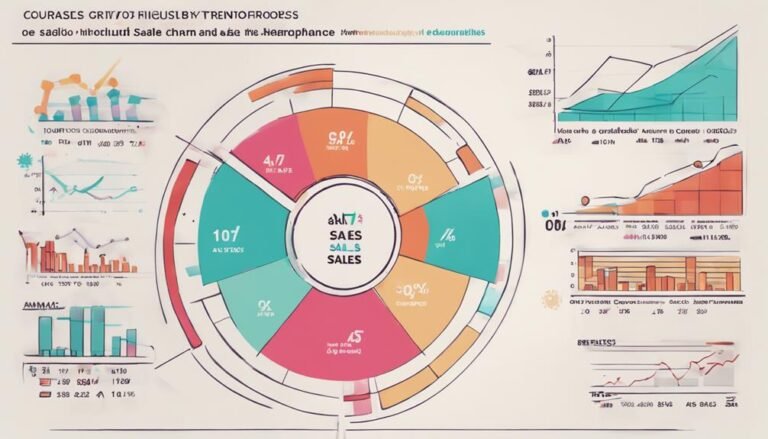What Are the Best Ways to Use Retargeting in Course Marketing?
Maximize your course marketing by retargeting interested individuals. Utilize cookies to track behavior and display tailored ads. Focus on conversion optimization for better results. Set clear campaign objectives targeting engagement and enrollment. Segment your audience based on interests and demographics. Craft compelling ad creatives with visual storytelling and effective call-to-action. Implement dynamic strategies for personalized engagement, mentioning specific courses. Utilize behavioral targeting for relevant content and high conversion rates. Analyze campaign performance through conversion tracking and A/B testing. Optimize continuously for maximum results. Harness the power of retargeting to boost engagement and conversion rates effectively.
Key Takeaways
- Utilize cookies to track online behavior for personalized retargeting.
- Display tailored ads to remind potential students of your course.
- Implement dynamic retargeting strategies for enhanced engagement.
- Segment audience based on interests and demographics for targeted messaging.
- Analyze user behavior and optimize campaigns for maximum conversion rates.
Understanding Retargeting in Course Marketing
To fully grasp the power of retargeting in course marketing, you must understand how this strategic tool can greatly enhance your conversion rates and engagement with potential students. Retargeting tactics involve targeting individuals who've already shown interest in your course by visiting your website or engaging with your content. By utilizing cookies to track their online behavior, you can strategically display tailored ads to these prospects as they browse the web, reminding them of your course and encouraging them to take the next step.
Conversion optimization is key when implementing retargeting tactics. It involves analyzing data to understand which ads, messaging, or offers resonate best with your target audience. By continuously testing and refining your retargeting campaigns based on these insights, you can improve the effectiveness of your ads and drive more conversions. Remember, the goal isn't just to reach potential students but to engage them in a way that compels them to enroll in your course. By mastering retargeting tactics and focusing on conversion optimization, you can maximize the impact of your course marketing efforts.
Setting Clear Campaign Objectives
When setting campaign objectives for your retargeting efforts, focus on clear goal-setting strategies to guarantee that your marketing initiatives align with your overall course promotion objectives.
Identify your target audience meticulously to tailor your retargeting messages effectively and boost engagement.
Goal Setting Strategies
Crafting precise and measurable campaign objectives is essential for successful retargeting strategies in course marketing. When setting goals, focus on metrics tracking to gauge the effectiveness of your retargeting efforts.
Define clear engagement goals such as increasing course sign-ups, boosting webinar attendance, or enhancing course completions. By establishing specific targets, like a 20% increase in course enrollment within a month, you provide a clear direction for your retargeting campaigns.
These objectives help you track progress, optimize your strategies, and make sure that your retargeting efforts align with your overall course marketing goals. Remember, setting achievable and realistic goals is vital for driving successful outcomes through retargeting in course marketing.
Target Audience Identification
Identifying your target audience with precision is essential for setting clear campaign objectives in retargeting strategies for course marketing. To effectively reach your audience, start by creating detailed personas that represent your ideal students.
Conduct thorough demographic analysis and segmentation to understand their age, gender, location, interests, and behavior patterns. By utilizing this information, you can tailor your retargeting campaigns to specific audience segments, enhancing the likelihood of engagement and conversion.
Targeting individuals who've already shown interest in your courses can greatly improve the effectiveness of your marketing efforts. Setting clear objectives based on this targeted approach will help you maximize the impact of your retargeting campaigns and drive better results for your course marketing initiatives.
Segmenting Your Audience Effectively
To effectively segment your audience in course marketing, consider analyzing their behavior patterns and interests to tailor your retargeting strategies accordingly. By dividing your audience into more targeted segments, you can create personalized messaging that resonates with each group, increasing the likelihood of conversion.
Here are three key strategies for effective audience segmentation:
- Behavioral Targeting: Utilize data on how users interact with your course offerings to create segments based on their actions. For example, you can separate those who've visited your course page but not enrolled from those who've already signed up. This allows you to tailor retargeting messages based on their stage in the customer journey.
- Interest-Based Segmentation: Segment your audience based on their interests and preferences related to your course topics. This could involve grouping individuals who've shown interest in similar courses or subjects, enabling you to deliver targeted content that aligns with their passions.
- Demographic Segmentation: Divide your audience based on demographic factors such as age, location, or occupation. This type of segmentation can help you craft retargeting campaigns that appeal to specific demographic groups, ensuring your messaging is relevant and engaging.
Crafting Compelling Ad Creatives
When crafting compelling ad creatives for your course marketing, consider leveraging visual storytelling techniques to engage your audience effectively.
Implementing strategic call-to-action strategies can drive conversions and encourage potential students to take the next step.
Maintaining brand consistency across your ads will help reinforce your course's identity and build trust with your target audience.
Visual Storytelling Techniques
Crafting compelling ad creatives through visual storytelling techniques is crucial for effectively utilizing retargeting in course marketing campaigns. To engage your audience and create a lasting impact, consider the following strategies:
- Emotional Appeal: Use visuals that evoke emotions like joy, curiosity, or inspiration to captivate your audience.
- Consistent Branding: Guarantee your visual content aligns with your brand identity to establish a strong connection with viewers.
- Interactive Elements: Incorporate interactive features like quizzes or polls into your ad creatives to boost engagement and encourage interaction.
Call-To-Action Strategies
Implementing effective call-to-action strategies is crucial for creating compelling ad creatives that drive engagement and conversions in course marketing campaigns.
To optimize conversions, focus on clear and persuasive copywriting techniques in your CTAs. Use action-oriented language like 'Enroll Now' or 'Start Learning Today' to prompt immediate responses from your audience.
A/B testing different CTAs can help determine which phrases resonate best with your target market, leading to higher click-through rates and conversions.
Incorporating a sense of urgency, such as limited-time offers or exclusive deals, can further motivate potential students to take action.
Brand Consistency Tips
To enhance the impact of your course marketing campaigns, make sure that your ad creatives maintain consistent branding elements for a cohesive and recognizable visual identity. Consistent messaging and brand image are key components when crafting compelling ad creatives.
Here are three tips to help you achieve brand consistency in your course marketing retargeting efforts:
- Use consistent color schemes: Stick to your brand's color palette to guarantee that your ads align with your overall brand identity.
- Include your logo: Incorporating your logo prominently in your ad creatives helps reinforce brand recognition.
- Maintain consistent typography: Using the same fonts across your ads contributes to a cohesive and professional look that reinforces your brand image.
Implementing Dynamic Retargeting Strategies
Engage your audience effectively by tailoring dynamic retargeting strategies to rekindle their interest in your course offerings. Utilizing personalized messaging in your retargeting campaigns can greatly enhance engagement. By addressing users by their names or referencing specific courses they showed interest in, you create a more personalized experience that resonates with potential students.
Behavioral targeting is another powerful tool in dynamic retargeting. Analyzing user behavior such as the courses they viewed, how long they spent on certain pages, or whether they added courses to their carts can help you create targeted ads that align with their interests. For instance, if a user spent time exploring photography courses, you can retarget them with ads showcasing upcoming photography workshops or advanced photography classes.
Implementing dynamic retargeting strategies that incorporate personalized messaging and behavioral targeting can boost your course enrollment rates by keeping your offerings top of mind for potential students. Remember, the key is to deliver relevant content that speaks directly to each user's interests and needs.
Analyzing and Optimizing Campaign Performance
To enhance the effectiveness of your retargeting campaigns, it's crucial to thoroughly analyze and optimize the performance of each campaign. Here are some key strategies to help you analyze and optimize your retargeting campaign performance:
- Conversion Tracking: Implement robust conversion tracking to monitor the actions users take after clicking on your retargeting ads. This data is invaluable in understanding the effectiveness of your campaigns and identifying areas for improvement.
- A/B Testing: Conduct A/B tests on different elements of your retargeting ads, such as ad copy, visuals, and calls to action. By testing variations and analyzing the results, you can refine your campaigns to maximize conversion rates.
- Optimization Strategies: Continuously optimize your campaigns based on the insights gathered from conversion tracking and A/B testing. Adjust targeting parameters, messaging, and timing to make sure your retargeting efforts yield the best possible results.
Conclusion
As you navigate the world of course marketing, remember that the key to success lies in harnessing the power of retargeting. By setting clear objectives, segmenting your audience strategically, and crafting engaging ad creatives, you can effectively engage potential students and drive conversions.
Implement dynamic retargeting strategies to stay top-of-mind with your audience and continuously analyze campaign performance for best results. With these tactics in place, your course marketing efforts are sure to thrive.







